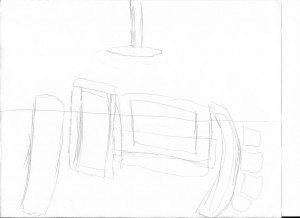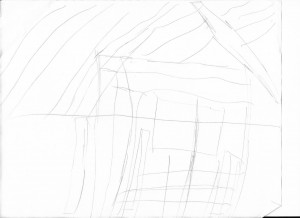I have never knowingly been to Vinegar Hill, although in the past year I have been downtown Brooklyn many times, and over the course of my short lived life span. I am a little anxious to go, and after reading the some of its history I am very interested. I am however trying to not set my expectations so high for what the sight may look like, so I am trying to keep my mind as open as possible until we actually visit the site. I do however hope that the places looks very cool and has some type of visual history but I will definitely be waiting until I see the site in person before coming to a conclusion about my thoughts.
WikiGalaxy and Primary, Secondary, and Tertiary Sources
After viewing the video and reading about the WikiGalaxy, along with the article about primary, secondary, and tertiary sources, I find that a visualization about the relevance of sources and their relationships indicated by a link, the yellow line, is “pretty” amazing. To be able to see and sense the closeness or distances of the relationships of sources can provide another means of gauging how well or important sources would be to my research. This would aid in keeping me “on-track” and in helping me to save time on gathering relevant information for my researches. I will no longer be swamped by, literally, millions of search results and be forced to rummage through seemingly infinite amounts of data that would cost me invaluable time, energy, resources, etc. I would not have to rely solely on trying to figure out “keywords,” appropriate databases, and ideal search engines. I could now see how closely articles would be related to my topics. I like this “new” feature!
Wiki galaxy & 3 types of Sources, Reflection # 3
As looking at the wikigalaxy its looks really cool but it would be nice for users to be able to create custom galaxies, galaxies with set limits, meaning that show only those pages that fit a specific category. Its almost the same idea like google earth, but just like article mentioned it has only 100,000 articles so far i think in future wikigalaxy will be a useful tool to have it.
Article on types of sources is really clear and easy to follow, now at least i can tell the difference between primary, secondary and tertiary sources. I feel like secondary and tertiary sources are related to one another.
Drawing
Collaborative Map
Here’s a google map that we can add to as the semester progresses. We can embed images, links, and GIS data. I’ve dropped a pin at the meeting site for our field work on Wednesday (2.10.16).
To learn more about google maps and how to edit them, check out this documentation.
Reflection of the Whiskey Wars
After reading this article it’s no surprise to me that this time was filled with corruption. By the looks of it it isn’t much different from our current times in 2016. While there are obvious differences such as no raids of distilleries or factories, corruption within our corporations is still a huge problem. I learned that what is now called Vinegar Hill was once called Irishtown due to the massive influx of irish immigrants. Also I found that President Ulysses S. Grant’s secretary was found to be apart of a huge whiskey ring which I found ironic! I can’t wait to visit this area with the class.
Whiskey Wars
I had heard of Vinegar Hill about a year ago but knew nothing about the neighborhood. Coming from living 25 years in eastern Long Island, I know making a life in the Brooklyn/Queens areas, I’d take whatever opportunities I could about the histories of what I now call home. The Whiskey Wars article immediately made me think of the backwards actions of todays government with surge taxing on the necessities that we as people require most, or products with the most demand. Tax breaks on the richest, but spiked taxing on the lower and middle class and only making them higher. “Mom and pop” shops and small businesses being overshadowed and turned out of business because they cannot afford it. To me, the Whiskey Wars and the attacks on Brooklyn distilleries in the 1860s, with liquor being dumped out and wasted when all of that product could have been huge profit for the distillers.
The Whiskey Wars
The Whiskey Wars was a very interesting reading that I feel most New Yorkers, or specifically Brooklynites know about. Apparently the vinegar hill area of Brooklyn was full of illegal distillery’s, were manufacturers were trying to avoid paying the federal tax at the time on alcohol. The 1860’s in Brooklyn was full of federal raids and riots on behalf the whiskey runners. I guess New Yorkers have always been trying to avoid pay taxes.
-Frank Smith
Whiskey Wars, Visual Notes – Chapter 1: Introduction & Chapter 3: A Journal
When I reflect on the Whiskey Wars, the illustration of the soldiers in conflict with the mob of protesters and hostile people are affected and greatly influenced by my reading of chapters one and three from the Visual Notes text. I see that the newspaper served as a form of a descriptive sketch and journal that not only depicted the seemingly unbiased view of the reporter, but also the capacity of the accuracy of the scene of the event to be influenced by the reporter’s experiences and preconceived notions. I did not read the original newspaper article from the mid-to-late 1800s, but I tend to observe from the illustration that the protesters and hostile people were more enraged and confrontational than the soldiers were, even though there were seemingly equal amounts of people and soldiers on both sides. I saw that the expressions of the protesters and hostile people were more animated with intolerance, anger, and rage, while the soldiers’ faces were mostly not drawn towards the reader(s) perspective, and the ones who could be seen had neutral expressions that were left to the reader(s) to decide on the emotions in an abstract sense.
I think that the Whiskey Wars were indicative of much corruption on all levels with bribery and criminal activities of that era, but to get a true sense of the actual events would have to have been directly experienced by myself. Only then, my conclusions would have been unaffected by the direct reference of the newspaper illustration and the author’s description, and only by my own biases. Visual Notes prescribe looking through a “clear,” an “accurate,” and an “acute” perspective, in order to translate an unbiased representation of a scene or event.
Sketches and journals add to the quality of information and knowledge. There is more learning and creativity involved when there are sketches that show the indirect and unseen and when there are journal concepts, thoughts, interpretations, and reflections that assist in linking and associating concepts.
PRE-VISIT REFLECTION
Please click on the following link to read the edited portion of my PRE-VISIT REFLECTION on the Learning Places Library / Archive Report in PDF format: CopyofLearningPlacesLibraryArchiveReportPreSiteVisitReflection





